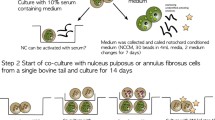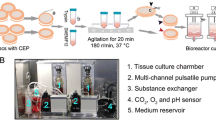Abstract
Purpose
An in vitro study using human intervertebral disc nucleus pulposus cells to evaluate the effects of CC stimulation on disc-matrix macromolecule production.
Methods
Nucleus pulposus cells were cultured in alginate beads and treated with CC stimulation. The effect of BMP on CC stimulation of the cells was evaluated by applying a BMP blocker (noggin) or by applying additional BMP-7 to the culture. The mRNA levels of the disc extracellular matrix genes (collagen I, II, aggrecan) and BMPs were measured by real-time PCR. The protein levels of aggrecan, collagen II, and BMPs were determined by ELISAs and Western blots. Sulfated glycosaminoglycan (sGAG) content was assayed using the DMMB method.
Results
(1) CC stimulation upregulates the production of the disc-matrix macromolecular components: sGAG, aggrecan and collagen II; (2) CC stimulation increases the ratio of mRNA expression levels of collagen II to collagen I; (3) CC stimulation induces the expression of endogenous BMP-4 and BMP-7; (4) inhibition of BMP activity (using noggin) reduces CC-mediated upregulation of aggrecan and collagen II; (5) CC and BMP-7 act in synergy to increase the upregulation of disc-matrix macromolecules.
Conclusion
CC stimulation upregulates the production of the intervertebral disc-matrix macromolecules aggrecan, collagen II, and sGAG by a mechanism involving BMPs. CC stimulation acts in synergy with BMP-7 to increase the upregulation of these disc-matrix macromolecules.






Similar content being viewed by others
Abbreviations
- CC:
-
Capacitively coupled electrical stimulation
- IVD:
-
Intervertebral disc
- sGAG:
-
Sulfated glycosaminoglycan
- NP:
-
Nucleus pulposus
- DMMB:
-
Dimethylmethylene blue
- ELISA:
-
Enzyme linked immunosorbent assay
- BMP:
-
Bone morphogenic proteins
References
Masuda K (2008) Biological repair of the degenerated intervertebral disc by the injection of growth factors. Eur Spine J Suppl 4:441–451. doi:10.1007/s00586-008-0749-z
Yoon ST, Patel NM (2006) Molecular therapy of the intervertebral disc. Eur Spine J Suppl 3:S379–S388
Masuda K, An HS (2006) Prevention of disc degeneration with growth factors. Eur Spine J 15(Suppl 3):S422–S432
An HS, Thonar EJ, Masuda K (2003) Biological repair of intervertebral disc. Spine (Phila Pa 1976) 28:S86–S92
Kepler CK, Anderson DG, Tannoury C, Ponnappan RK (2011) Intervertebral disk degeneration and emerging biologic treatments. J Am Acad Orthop Surg 19(9):543–553
Masuda K, Takegami K, An H, Kumano F, Chiba K, Andersson GB, Schmid T, Thonar E (2003) Recombinant osteogenic protein-1 upregulates extracellular matrix metabolism by rabbit annulus fibrosus and nucleus pulposus cells cultured in alginate beads. J Orthop Res 21(5):922–930
An HS, Takegami K, Kamada H, Nguyen CM, Thonar EJ, Singh K, Andersson GB, Masuda K (2005) Intradiscal administration of osteogenic protein-1 increases intervertebral disc height and proteoglycan content in the nucleus pulposus in normal adolescent rabbits. Spine 30(1):25–31
Masuda K, Imai Y, Okuma M, Muehleman C, Nakagawa K, Akeda K, Thonar E, Andersson G, An HS (2006) Osteogenic protein-1 injection into a degenerated disc induces the restoration of disc height and structural changes in the rabbit anular puncture model. Spine 31:742–754
Imai Y, Okuma M, An HS, Nakagawa K, Yamada M, Muehleman C, Thonar E, Masuda K (2007) Restoration of disc height loss by recombinant human osteogenic protein-1 injection into intervertebral discs undergoing degeneration induced by an intradiscal injection of chondroitinase ABC. Spine 32:1197–1205
Carragee EJ, Don AS, Hurwitz EL, Cuellar JM, Carrino JA, Herzog R (2009) 2009 ISSLS prize winner: does discography cause accelerated progression of degeneration changes in the lumbar disc: a 10-year matched cohort study. Spine 34(21):2338–2345
Eder C, Pinsger A, Schildboeck S, Falkner E, Becker P, Ogon M (2013) Influence of intradiscal medication on nucleus pulposus cells. Spine J 13(11):1556–1562
Gruber HE, Rhyne AL 3rd, Hansen KJ et al (2012) Deleterious effects of discography radiocontrast solution on human annulus cell in vitro: changes in cell viability, proliferation, and apoptosis in exposed cells. Spine J 12(4):329–335
Walsh AJ, Bradford DS, Lotz JC (2004) In vivo growth factor treatment of degenerated intervertebral discs. Spine (Phila Pa 1976) 29(2):156–163
Carragee EJ, Hurwitz EL, Weiner BK (2011) A critical review of recombinant human bone morphogenetic protein-2 trials in spinal surgery: emerging safety concerns and lessons learned. Spine J 11:471–491
Carragee EJ, Chu G, Rohatgi R et al (2013) Cancer risk after use of recombinant bone morphogenetic protein-2 for spinal arthrodesis. J Bone Joint Surg Am 95(17):1537–1545
Griffin M, Iqbal SA, Sebastian A, Colthurst J, Bayat A (2011) Degenerate wave and capacitive coupling increase human MSC invasion and proliferation while reducing cytotoxicity in an in vitro wound healing model. PLoS One 6(8):e23404
Brighton CT, Hozack WJ, Brager MD, Windsor RE, Pollack SR, Vreslovic EJ, Kotwick JE (1985) Fracture healing in the rabbit fibula when subjected to various capacitively coupled electrical fields. J Orthop Res 3(3):331–340
Wang Z, Clark CC, Brighton CT (2006) Up-regulation of bone morphogenetic proteins in cultured murine bone cells with use of specific electric fields. J Bone Joint Surg Am 88:1053–1065
Scott G, King JB (1994) A prospective, double-blind trial of electrical capacitive coupling in the treatment of non-union of long bones. J Bone Joint Surg Am 76(6):820–826
Fredericks DC, Smucker J, Petersen EB, Bobst JA, Gan JC, Simon BJ, Glazer P (2007) Effects of direct current electrical stimulation on gene expression of osteopromotive factors in a posterolateral spinal fusion model. Spine (Phila Pa 1976) 32(2):174–181
Lorich DG, Brighton CT, Gupta R, Corsetti JR, Levine SE, Gelb ID, Seldes R, Pollack SR (1998) Biochemical pathway mediating the response of bone cells to capacitive coupling. Clin Orthop Relat Res 350:246–256
Goodwin CB, Brighton CT, Guyer RD, Johnson JR, Light KI, Yuan HA (1999) A double-blind study of capacitively coupled electrical stimulation as an adjunct to lumbar spinal fusions. Spine (Phila Pa 1976) 24(13):1349–1356
Wan DC, Pomerantz JH, Brunet LJ, Kim JB, Chou YF, Wu BM, Harland R, Blau HM, Longaker MT (2007) Noggin suppression enhances in vitro osteogenesis and accelerates in vivo bone formation. J Biol Chem 282(36):26450–26459
Author information
Authors and Affiliations
Corresponding author
Ethics declarations
Conflict of interest
None.
Rights and permissions
About this article
Cite this article
Wang, Z., Hutton, W.C. & Yoon, S.T. The effect of capacitively coupled (CC) electrical stimulation on human disc nucleus pulposus cells and the relationship between CC and BMP-7. Eur Spine J 26, 240–247 (2017). https://doi.org/10.1007/s00586-016-4439-y
Received:
Revised:
Accepted:
Published:
Issue Date:
DOI: https://doi.org/10.1007/s00586-016-4439-y




